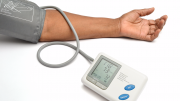According to the International Society of Hypertension, high blood pressure causes over 10 million deaths each year [1] and is the most significant single contributing risk factor to global death [2]. This is especially worrying in the case of obese people, because obesity is a major cause of hypertension, accounting for 65-75% of the risk for essential hypertension [3]. Following a study by Framingham, 78% of hypertension in men and 65% in women can be attributed to excess weight gain [4]. With obesity rising fast as a burden of cardiovascular risk -it went from the fifth to the third position between 2000 and 2013 [5]-, controlling hypertension in obese individuals is crucial.
However, obtaining accurate readings in this subgroup with traditional devices has been so far challenging: large and extra-large cuffs and bladders in most home blood pressure monitors are scarce, cone-shaped arms make difficult or impossible to wrap the arm with a thigh cuff evenly (and therefore, blood pressure is overestimated) and subcutaneous adiposity thickness affects the artery compression and thus can lead to incorrect readings.
Now, the OMRON RS7 Intelli IT extends OMRON’s long-standing tradition of accuracy and relentless pursue of quality to the field of wrist blood pressure monitors. Therefore, obese people will gain accurate readings of their blood pressure, to make -together with their Doctor- informed medical and lifestyle decisions [6]. Naturally, it is also validated for use in the general population.
According to the protocol set by the European Society of Hypertension, the clinical validation of the OMRON RS7 Intelli IT demonstrated accurate results equivalent to those obtained in the doctor’s office. In correlation with these results, the ESC/ESH Guidelines for the Management of Arterial Hypertension recommend basing the diagnosis of hypertension on out-of-office measurement with home blood pressure monitors.
“OMRON firmly believes in the need to go further than just getting clinical validation in the general population but also carrying out trials in specific populations such as the obese, pregnant women and diabetic patients. The results from the clinical validation in obese people have strongly confirmed our beliefs and we are proud to offer more and more professionalized devices over time”, said Lucia Prada, Marketing Director of OMRON Healthcare Europe.
A new wrist range that brings unique benefits for consumers
One of the most frequent concerns about the wrist devices is that an incorrect positioning affects the accuracy of the reading. This is no longer the case with OMRON RS7 Intelli IT, since it is equipped with an advanced, one of a kind LED positioning sensor, which flashes if the arm is not correctly positioned (at the level of the heart). To add more, the new OMRON RS7 Intelli IT syncs with the OMRON connect app, so that users can track their progress over time. It also includes hypertension indicator, average function, stores up to 100 memories and allows 2 users.
In addition to the RS7 Intelli IT, OMRON will launch a whole new range of wrist devices, also clinically validated for use in generic population, featured with different functions, to address various types of needs and lifestyle. The whole range is easy to use on the wrist, very silent, tubeless, small and portable -ideal for travelling-, sleek and compact.
This new technology is part of a series of developments deeply rooted in OMRON’s Japanese heritage of innovation. Designing wearables to be used on the go, OMRON is enabling patients to get real-time insights on their situation, so that they can be in control of their body and make appropriate medical and lifestyle decisions to live with zero compromise on health.
References
1 Obtained from www.maymeasure.com
2 Obtained from www.maymeasure.com
3 (Incidence and precursors of hypertension in young adults: the Framingham Offspring Study. Prev Med. 1987;16:235–251).
4 Kannel W.B. Framingham study insights into hypertensive risk of cardiovascular disease. Hypertens Res. 1995 Sep;18(3):181-96.
5 Lancet, 2015. http://dx.doi.org/10.1016/S0140-6736
6 Clinically validated in patients with arm circumference ≥ 32 cm and wrist circumference: 13.5-21.5 cm





